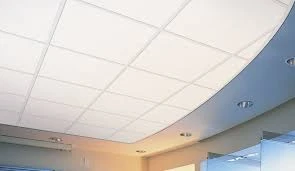10 月 . 05, 2024 23:51 Back to list
fiber false ceiling materials
Exploring Fiber False Ceiling Materials A Comprehensive Overview
In the realm of modern architecture and interior design, false ceilings have become an essential element in creating aesthetically pleasing and functional spaces. Among the various materials available for false ceilings, fiber-based options offer a unique blend of versatility, durability, and aesthetic appeal. This article delves into the characteristics, benefits, and applications of fiber false ceiling materials.
What Are Fiber False Ceilings?
Fiber false ceilings are constructed using a variety of fibrous materials, often including glass fibers, mineral fibers, or synthetic fibers. These materials are known for their lightweight properties and ease of installation, making them a popular choice for residential, commercial, and industrial applications. Fiber ceilings can be manufactured in a multitude of designs, colors, and textures, providing invaluable options for designers and architects.
Benefits of Fiber False Ceiling Materials
1. Lightweight and Easy to Install One of the most significant advantages of fiber ceiling materials is their lightweight nature. This characteristic simplifies transportation and installation, reducing labor costs and time. As a result, many contractors prefer fiber ceilings, especially in large-scale projects.
2. Acoustic Performance Fiber ceilings excel in sound absorption, making them an ideal choice for spaces where noise control is crucial, such as offices, auditoriums, and classrooms. The porous nature of fiber materials helps in dampening unwanted noise, thereby enhancing the overall acoustic environment.
3. Fire Resistance Safety concerns are paramount in building design, and fiber false ceilings often have excellent fire-resistant properties, especially when treated with fire-retardant chemicals. This feature makes them suitable for various commercial applications, including theaters, restaurants, and shopping centers.
4. Moisture Resistance Certain fiber-based materials, such as mineral fiber tiles, exhibit high resistance to moisture. This quality makes them suitable for humid environments like kitchens and bathrooms, where traditional ceiling materials may warp or degrade over time.
5. Variety of Design Options Fiber false ceilings come in various styles, colors, and textures, allowing for innovative design solutions. Whether aiming for a sleek modern look or a more traditional aesthetic, fiber ceilings can be customized to meet specific design requirements. Additionally, they can accommodate integrated lighting fixtures, enhancing the overall ambiance of a space.
fiber false ceiling materials

6. Energy Efficiency Some fiber materials provide thermal insulation, contributing to a building's energy efficiency. By maintaining a stable indoor temperature, these ceilings can help reduce air conditioning and heating costs over time.
Installation and Maintenance
Installing fiber false ceilings typically involves a simple framework system suspended from the main ceiling. This framework is then covered with fiber ceiling tiles or panels. With proper installation, maintenance is minimal; most fiber ceilings can be easily cleaned with a damp cloth or vacuumed to remove dust and debris.
Applications of Fiber False Ceilings
1. Commercial Spaces Offices, malls, and retail outlets frequently utilize fiber false ceilings due to their aesthetic versatility and acoustic properties, creating professional and pleasant environments for staff and customers alike.
2. Residential Areas Homes often feature fiber ceilings in living rooms, bedrooms, and dining areas. Homeowners appreciate the decorative potential and the ability to hide electrical wirings and HVAC systems.
3. Educational Institutions Schools and universities often implement fiber ceilings to create sound-dampening environments conducive to learning. The aesthetic options available can enhance the overall campus and classroom design.
4. Healthcare Facilities Hospitals and clinics benefit from fiber ceiling materials, particularly for their hygienic properties and easy maintenance. Many fiber ceilings can be treated to inhibit mold and bacterial growth, which is essential for maintaining health standards.
Conclusion
In conclusion, fiber false ceiling materials serve as a perfect choice for architects and designers looking to blend functionality with aesthetic appeal. Their lightweight nature, acoustic benefits, fire and moisture resistance, and variety of design options make them an unbeatable selection for modern constructions. As the demand for innovative building materials continues to grow, fiber ceilings remain a staple in both residential and commercial spaces, proving that practicality can coalesce beautifully with design.
-
Revolutionizing Interior Design with Ceilings t grid Suspended SystemNewsOct.29,2024
-
Revolutionizing Ceiling Design with ceiling access panel with Gypsum Tile WaterproofNewsOct.29,2024
-
Revolutionizing Interior Design with PVC Gypsum Ceiling: A Comprehensive GuideNewsOct.29,2024
-
Elevating Interior Design with High quality Mineral Fiber Ceiling TilesNewsOct.29,2024
-
Revolutionizing Interior Design with PVC Gypsum Ceiling: A Comprehensive GuideNewsOct.29,2024
-
Elevating Interior Design with High-Quality Mineral Fiber Ceiling Tiles: A Comprehensive GuideNewsOct.29,2024







